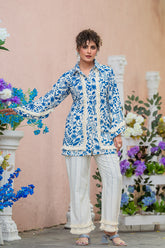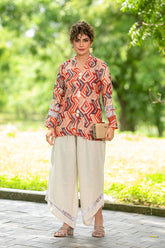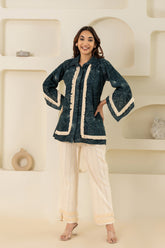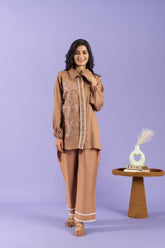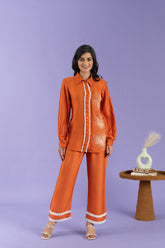Couture vs Ready to Wear History Trends and the Future of Fashion
 Fashion is always changing, mixing creativity, luxury, and tradition. Two main parts of the fashion world are couture and ready-to-wear. They are different in how they're made and who buys them, but both are important for setting trends and influencing what we wear every day.
Fashion is always changing, mixing creativity, luxury, and tradition. Two main parts of the fashion world are couture and ready-to-wear. They are different in how they're made and who buys them, but both are important for setting trends and influencing what we wear every day.
Couture fashion is all about custom-made designs, often shown at events like Fashion Week. It has a big impact on current styles. Ready-to-wear fashion offers more affordable choices for everyone. This blog will look at where couture and ready-to-wear came from, how they influence fashion, and how they affect the clothes we wear today.
Introduction to Couture Fashion
What is couture fashion?
Couture (often referred to as haute couture fashion garments) is the epitome of luxury in the fashion world and its evolving wardrobe choices. Couture garments are custom-made, high-end creations designed to fit a client's specific measurements and style preferences. Each couture piece is crafted with the highest level of craftsmanship and intricate detailing and often requires hours of painstaking high sewing by skilled artisans.
Historically, couture fashion has been associated with elite fashion houses, especially those in French fashion, such as haute couture houses like Dior, Chanel, and Givenchy. Haute couture collections are presented during exclusive events like Couture Week, where fashion designers showcase their couture collections to an audience of fashion editors, celebrities, and high-profile clients.
The History and Evolution of Couture Fashion
The term “couture” originated from the Chambre Syndicale de la Haute Couture in France, which was formed in the mid-19th century to regulate haute couture fashion. Charles Frederick Worth, an English designer, is often credited with being the first tip of the iceberg in the world of couture. couture designer to establish a fashion house in Paris and create couture clothing for an elite clientele. Over time, couture houses became synonymous with craftsmanship, luxury, and exclusivity.
The evolution of fashion week has highlighted the importance of ready-to-wear. Couture fashion has seen a shift from the traditional styles of the past to more modern and bold fashion choices interpretations of classic designs. Haute couture pieces today may incorporate ethnic, bohemian, or even indo-western influences; creating a fusion of cultural and festive attire can be enhanced with layers and vibrant colors. styles.
Haute Couture vs Ready to Wear
The primary difference between haute couture and ready-to-wear has distinct influences on modern attire. lies in production methods. While couture garments are handcrafted, tailored to individual clients, and produced in limited quantities, ready-to-wear clothing is mass-produced in standard sizes and made available to a broader market, including Style and fashion options.
The Role of Ready-to-Wear in high Fashion
What is Ready-to-Wear Fashion?
Ready to wear fashion refers to clothing designed by fashion designers for mass production. Unlike couture garments, ready-to-wear lines are manufactured in standard sizes and available for purchase at retail stores or online. This makes ready-to-wear fashion more accessible and affordable compared to the luxury and exclusivity of couture.
The ready to wear collections often include boho styles for a relaxed look. often reflect the fashion trends of the moment, designed to cater to a wide range of consumers. Over time, ready-to-wear fashion has evolved from being an alternative to couture to becoming a significant part of the clothing industry.
Transition from Haute Couture to Ready-to-Wear
In the mid-20th century, the clothing industry saw a significant shift with the rise of ready-to-wear lines. Designers like Coco Chanel, Yves Saint Laurent, and Jean-Paul Gaultier began introducing ready-to-wear clothing alongside their designer collections to cater to a growing demand for stylish yet more affordable options. Today, ready-to-wear and haute couture often coexist, with many fashion houses offering both categories in their fashion shows.
Popularity and Accessibility of Ready-to-Wear outfit
The ready-to-wear fashion market is vast, offering a wide array of styles, from casual to formal wear. As a result, ready-to-wear collections are more versatile and widely available compared to the often expensive and exclusive world of couture. This increased accessibility has made ready-to-wear the essential option for the majority of fashion consumers.
Trends in Couture and Ready to Wear Fashion
Current Trends in Both Couture and Ready-to-Wear
Fashion changes quickly, with new trends appearing every year. In couture fashion, designers often try very new and different things, pushing the limits of what’s possible with clothing and skill. Couture collections often include show-stopping styles, detailed prints, and luxurious fabrics meant to be noticed.
Ready-to-wear fashion focuses on trends that are more practical for everyday life, but still look great. People want clothes that are fashionable and can be worn in many different ways. More and more designers are also using materials that are better for the environment, responding to a growing interest in eco-friendly choices. If you're looking for the latest fast fashion trends at affordable prices, websites like znkl.in offer frequent refreshes of their collections.
The Impact of Social Media on Fashion Trends
Social media has drastically changed the way we perceive and engage with fashion. Platforms like Instagram and TikTok have made it easier for designers to showcase their designer collections to a global audience. Social media influencers and celebrities often set the tone for fashion trends, blurring the lines between ready-to-wear and couture. The rise of fast fashion has also made trends more accessible to the masses, creating a new dynamic in the fashion world.
How Trends Influence Both Haute Couture and Ready-to-Wear Designs
Trends in couture fashion often inspire ready-to-wear collections, and vice versa. A couture dress may be reimagined for mass production in a more affordable fabric, while a popular ready-to-wear outfit might inspire a new layer of creativity in fashion. couture piece. This fusion of couture and ready-to-wear ensures that fashion remains dynamic and exciting.
The Intersection of Couture Fashion and Ready-to-Wear
Blending Couture and Ready-to-Wear Elements
Many stylish fashion designers are bridging the gap between couture and ready-to-wear by blending elements of both categories in their collections, creating unique fashion choices. This fusion allows designers to offer high-end couture pieces that maintain the craftsmanship and artistry of haute couture while ensuring the accessibility and wearability of ready-to-wear.
The Influence of Couture Craftsmanship on Ready to Wear Collections
Even in ready-to-wear apparel, the influence of couture craftsmanship is undeniable. Fashion houses like Dior and Chanel have introduced elements of contemporary design into their collections. couture fashion into their ready to wear collections, elevating the overall quality and appeal of custom attire. ready-to-wear clothing. The intricate patterns, luxurious fabrics, and expert tailoring that define couture fashion are increasingly making their way into more affordable collections.
Designers Who Bridge the Gap Between Haute Couture and Ready-to-Wear
Several high-profile clothing designers are known for their ability to merge haute couture and ready-to-wear in their designs. For instance, Christian Dior has successfully maintained the allure of haute couture while making a statement with their unique attire. ready-to-wear lines that attract a wider audience. These designers understand the nuances of both worlds, creating pieces that appeal to a broad spectrum of fashion enthusiasts.
The Fashion Industry: Couture vs Ready-to-Wear
Market Dynamics: Couture Fashion and Its Niche Audiencev
Couture fashion caters to an elite group of consumers who seek exclusivity, luxury, and craftsmanship. Couture houses produce limited quantities of each couture piece, making these garments highly sought after by fashion connoisseurs. As a result, couture fashion remains a niche segment in the fashion industry, with high fashion choices price tags that reflect the cost of materials, labor, and expertise involved in creating couture garments.
Ready-to-Wear's Larger Impact on the Fashion Industry
Ready-to-wear apparel, by contrast, has a broader reach, impacting the mass market. With the rise of online shopping, ready-to-wear has become even more accessible, allowing fashion enthusiasts to buy Style and fashion pieces. ready-to-wear lines from the comfort of their homes. Fashion houses now produce ready-to-wear collections that cater to a wide range of tastes, from casual to chic and bold outfits.
The Growing Importance of Inclusivity in Ready to Wear Collections
One of the key differences between couture fashion and ready to wear fashion is the inclusivity of high-end fashion ready-to-wear collections. Designers are increasingly creating ready to wear clothing in a variety of sizes and styles to cater to diverse body types. This inclusivity is reshaping the fashion industry, encouraging fashion brands to consider all consumers when designing their collections.
Conclusion: The Future of Couture and Ready to Wear Fashion
The future of couture fashion and ready-to-wear fashion lies in the ability to elevate traditional techniques while embracing stylish sensibilities. As the fashion world moves forward, clothing designers will continue to blend couture and ready-to-wear elements, creating garments that are both luxurious and accessible. The importance of sustainable practices and inclusive designs will only grow as consumers demand more from the high-end fashion clothing industry.
Whether you prefer the exclusivity of couture or the accessibility of ready-to-wear, both categories will continue to shape the fashion trends of the future. Fashion houses will adapt to new consumer expectations, ensuring that both couture and ready-to-wear collections remain relevant in an ever-changing world.

